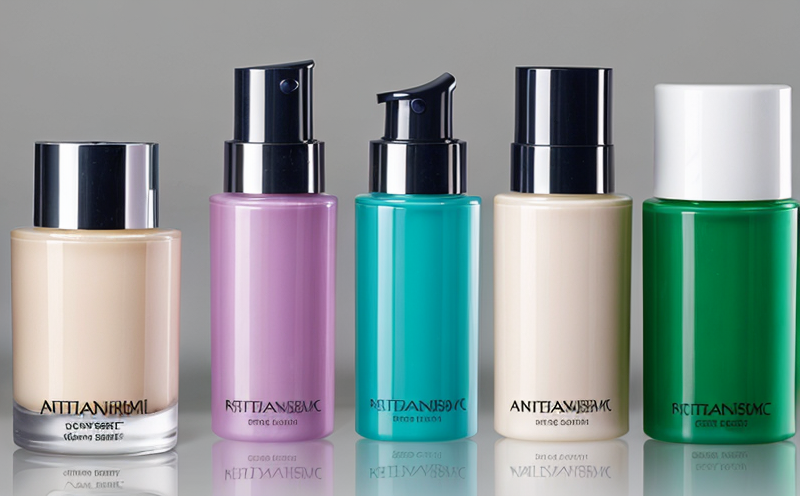USP 51 Antimicrobial Effectiveness Testing in Cosmetic Products
The United States Pharmacopeia (USP) Chapter Chapter 51, titled "Sterility and Preservation," specifies the requirements for ensuring that cosmetic products are preserved effectively to prevent contamination by microorganisms. This chapter is a critical part of the regulatory framework that governs the quality, safety, and efficacy of pharmaceutical products, including cosmetics.
The antimicrobial effectiveness testing outlined in USP 51 ensures that preservatives used in cosmetic formulations are capable of inhibiting or killing microbial growth. The test involves exposing microorganisms to the preservative under controlled conditions and then assessing its ability to inhibit microbial growth after a set incubation period. This process is essential for ensuring product safety and shelf-life.
The testing protocol begins with selecting appropriate microorganisms that are commonly associated with cosmetic products. These may include bacteria, fungi, and yeasts. The preservative concentration used in the test must be representative of its intended use in the product. Specimens are prepared by diluting the preservative to a range of concentrations, typically spanning from the lowest expected usage level to the highest.
The testing process involves incubating samples with the microorganisms under controlled conditions for a specified period, usually 28 days, which allows sufficient time for microbial growth and potential inhibition. After this period, the samples are tested for microbial content using appropriate microbiological methods such as agar plate counts or ATP bioluminescence assays.
The results of USP 51 testing are critical for quality managers and compliance officers to ensure that their products meet regulatory standards. It is a key step in the development and manufacturing process, ensuring that preservatives are effective against both Gram-positive and Gram-negative bacteria, as well as fungi and yeasts.
Understanding the nuances of this test is essential for R&D engineers who must design formulations that not only comply with regulations but also meet consumer expectations. The test results can influence product formulation decisions, including the choice of preservative and its concentration.
For procurement teams, understanding USP 51 testing ensures that they are sourcing high-quality ingredients that have been tested to ensure their efficacy as preservatives. This knowledge is crucial for maintaining a compliant supply chain and ensuring product safety and quality.
Why It Matters
The USP 51 antimicrobial effectiveness testing in cosmetic products is critical because it ensures that preservatives are effective against microorganisms, thereby maintaining the integrity and safety of the product. Ineffective preservation can lead to contamination, which not only poses a risk to consumers but also results in wasted resources and potential legal issues.
Microbial contamination can result in spoilage, leading to compromised product quality and potential health risks. By ensuring that preservatives are effective as per USP 51 guidelines, manufacturers can prevent such issues, thereby maintaining consumer trust and satisfaction.
The test also ensures compliance with regulatory requirements, which is essential for market access and avoiding legal penalties. Non-compliance can result in product recalls, fines, and damage to brand reputation. Understanding the importance of this testing process helps quality managers make informed decisions that align with both regulatory standards and consumer expectations.
Moreover, effective preservation enhances the shelf-life of cosmetic products, ensuring they remain stable and safe for extended periods. This is particularly important for high-risk products such as eye drops or topical creams, where microbial contamination can lead to severe health issues.
Industry Applications
- Eye drops
- Topical creams and lotions
- Mascaras and other makeup products
- Dental hygiene products
- Nail polishes and removers
- Shampoos and conditioners
- Sunscreens
- Cleansing gels and foams
The USP 51 testing is particularly relevant for these cosmetic products because they are often exposed to environmental conditions that can promote microbial growth. By ensuring that preservatives are effective, manufacturers can extend the shelf-life of these products while maintaining their safety.
International Acceptance and Recognition
- The USP 51 test is recognized globally for its stringent standards on antimicrobial effectiveness in cosmetics. Many countries, including the European Union (EU), have adopted this standard as part of their regulatory frameworks.
- The International Organization for Standardization (ISO) has also published similar guidelines that align with the principles outlined in USP 51.
Manufacturers who comply with USP 51 are recognized for adhering to high standards of product safety and quality, which can enhance their marketability internationally. Compliance with these tests is a key factor considered by regulatory bodies when approving cosmetic products for sale in various markets.





